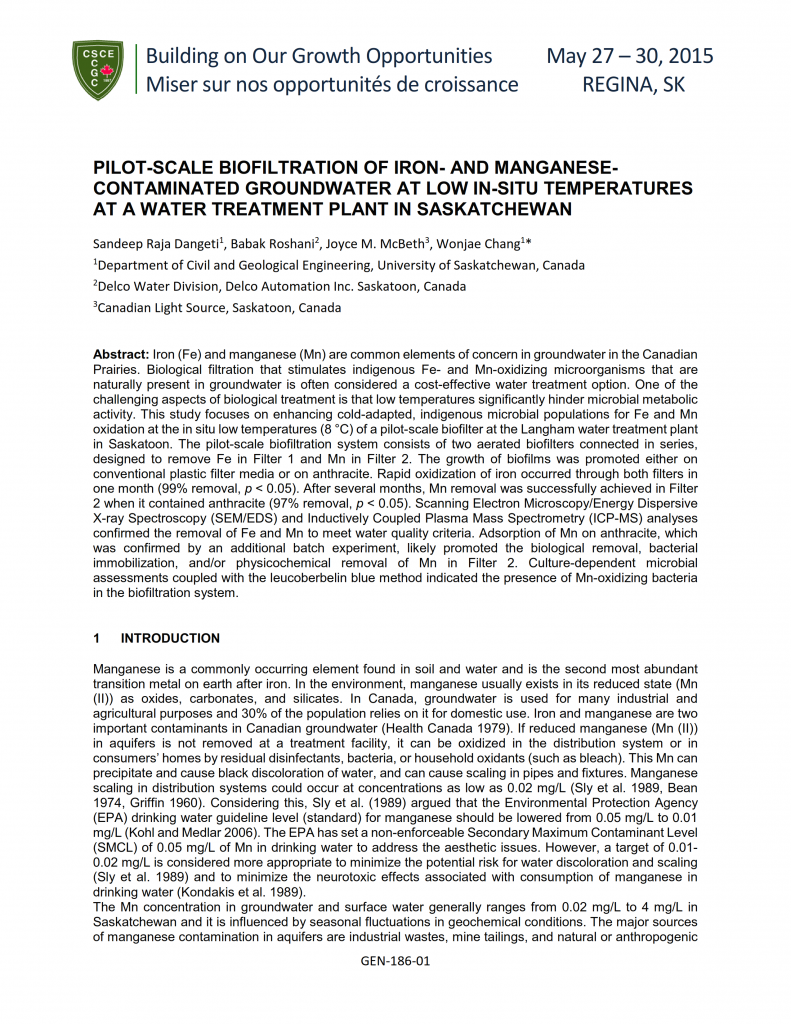Delco Water’s Technical Development Team is always exploring new frontiers in the water and wastewater industry. By constantly investigating and researching improved approaches for water treatment systems, we remain at the leading edge of exciting technology and your first choice for water treatment units. The following case studies highlight just a few of the communities we have helped, as well document the science behind our technologies.
Biofiltration as a Membrane Pre-Treatment Technology: A Success Story at Montana First Nation, AB, Canada
Groundwater is a major water resource in Canada and often encounters high levels of iron (Fe) and manganese (Mn). A membrane system, reverse osmosis (RO) (or) nanofiltration (NF), is less tolerant to direct treatment of groundwater with high levels of Fe and Mn. The presence of Fe and/or Mn in water sources leads to membrane fouling and frequent maintenance. Therefore, the limitations posed by membrane systems to treat Fe and Mn necessitates the addition of pre-treatment technologies to their treatment process.
Pilot-Scale Biofiltration of Iron- And Manganese- Contaminated Groundwater at Low In-Situ Temperatures at a Water Treatment Plant in Saskatchewan
Iron (Fe) and manganese (Mn) are common elements of concern in groundwater in the Canadian Prairies. Biological filtration that stimulates indigenous Fe- and Mn-oxidizing microorganisms that are naturally present in groundwater is often considered a cost-effective water treatment option. One of the challenging aspects of biological treatment is that low temperatures significantly hinder microbial metabolic activity. This study focuses on enhancing cold-adapted, indigenous microbial populations for Fe and Mn oxidation at the in situ low temperatures (8 °C) of a pilot-scale biofilter at the Langham water treatment plant in Saskatoon. The pilot-scale biofiltration system consists of two aerated biofilters connected in series, designed to remove Fe in Filter 1 and Mn in Filter 2. The growth of biofilms was promoted either on conventional plastic filter media or on anthracite. Rapid oxidization of iron occurred through both filters in one month (99% removal, p < 0.05). After several months, Mn removal was successfully achieved in Filter 2 when it contained anthracite (97% removal, p < 0.05). Scanning Electron Microscopy/Energy Dispersive X-ray Spectroscopy (SEM/EDS) and Inductively Coupled Plasma Mass Spectrometry (ICP-MS) analyses confirmed the removal of Fe and Mn to meet water quality criteria. Adsorption of Mn on anthracite, which was confirmed by an additional batch experiment, likely promoted the biological removal, bacterial immobilization, and/or physicochemical removal of Mn in Filter 2. Culture-dependent microbial assessments coupled with the leucoberbelin blue method indicated the presence of Mn-oxidizing bacteria in the biofiltration system.
Biofiltration Field Study for Cold Fe(II)- and Mn(II)-Rich Groundwater: Accelerated Mn(II) Removal Kinetics and Cold-Adapted Mn(II)-Oxidizing Microbial Populations
Removal of Mn(II) from Fe(II)- and Mn(II)-rich groundwater in cold regions is challenging, due to slow Mn(II) removal kinetics below 15 C. This study demonstrated onset, acclimation, and acceleration of Mn(II) removal in a two-stage pilot-scale biofilter (Fe and Mn filters) at varying low on-site temperatures (8–14.8 C). Mn(II) removal commenced at 8 C in the Mn filter after Fe(II) removal. A shift in redox-pH conditions favored biological Mn(II) removal and Mn(II)-oxidizing bacteria increased. The Mn filter reached steady-state functioning after 97 days, exhibiting high removal efficiencies (97 ± 0.9%). Yet, first-order rate constants (k) for Mn(II) removal were low (10 6–10 5 min 1;t1/2 ¼ ∼40 d). After consecutive backwashes and filter inoculation with backwashed sludge, k remarkably accelerated to 0.21 min 1 (t1/2 ¼ 3.31 min at 11 ± 0.6 C). The cold-adapted microbial consortium (51 genera), including Pseudomonas, Leptothrix, Flavobacterium, and Zoogloea, cultured from the field-aged biofilter rapidly produced biogenic Mn oxides at 8 C, confirmed by electron paramagnetic resonance spectroscopy. Birnessite and pyrolusite detected by synchrotron-based powder X-ray diffraction, and a repetitive birnessite-like surface morphology on ripened filter materials, reflected autocatalytic oxidation. Shifting in k indicated the vertical progress of biofilter ripening, which was not limited by low temperature.
Microbial Communities and Biogenic Mn-Oxides in an On-Site Biofiltration System for Cold Fe-(II)- and Mn(II)-Rich Groundwater Treatment
This study investigated relationships betweenmicrobial communities, groundwater chemistry, and geochemical and mineralogical characteristics in field-aged biofilter media from a two-stage, pilot-scale, flow-through biofiltration unit designed to remove Fe(II) and Mn(II) from cold groundwater (8 to 15 °C). High-throughput 16S rRNA gene amplicon sequencing of influent groundwater and biofilter samples (solids, effluents, and backwash water) revealed significant differences in the groundwater, Fe filter, and Mn filter communities. These community differences reflect conditions in each filter that select for populations that biologically oxidize Fe(II) and Mn(II) in the two filters, respectively. Genera identified in both filters included relatives of known Fe(II)-oxidizing bacteria (FeOB), Mn(II)-oxidizing bacteria (MnOB), and ammonia-oxidizing bacteria (AOB). Relatives of AOB and nitrite-oxidizing bacteria were abundant in sequencing reads from both filters. Relatives of FeOB in class Betaproteobacteria dominated the Fe filter. Taxa related to Mn-oxidizing organisms were minor members of the Mn-filter communities; intriguingly, while Alphaproteobacteria dominated (40 ± 10% of sequencing reads) the Mn filter community, these Alphaproteobacteria did not classify as known MnOB. Isolates from Fe and Mn filter backwash enrichment studies provide insight on the identity of MnOB in this system. Novel putative MnOB isolates included Azospirillum sp. CDMB, Solimonas soli CDMK, and Paenibacillus sp. CDME. The isolate Hydrogenophaga strain CDMN can oxidize Mn(II) at 8 °C; this known FeOB is likely capable of Mn(II) oxidation in this system. Synchrotron-based X-ray near-edge spectroscopy (XANES) coupled with electron paramagnetic resonance (EPR) revealed the dominant Mn-oxide that formed was biogenic birnessite. Co-existence of amorphous and crystallizedMn-oxide surfacemorphologies on the Mn-filtermedia suggest occurrence of both biological and autocatalytic Mn(II) oxidation in the biofilter. This study provides evidence that biofiltration is a viable approach to remove iron, manganese, and ammonia in cold groundwater systems, and that mineralogical and microbiological approaches can be used to monitor biofiltration system efficacy and function.




